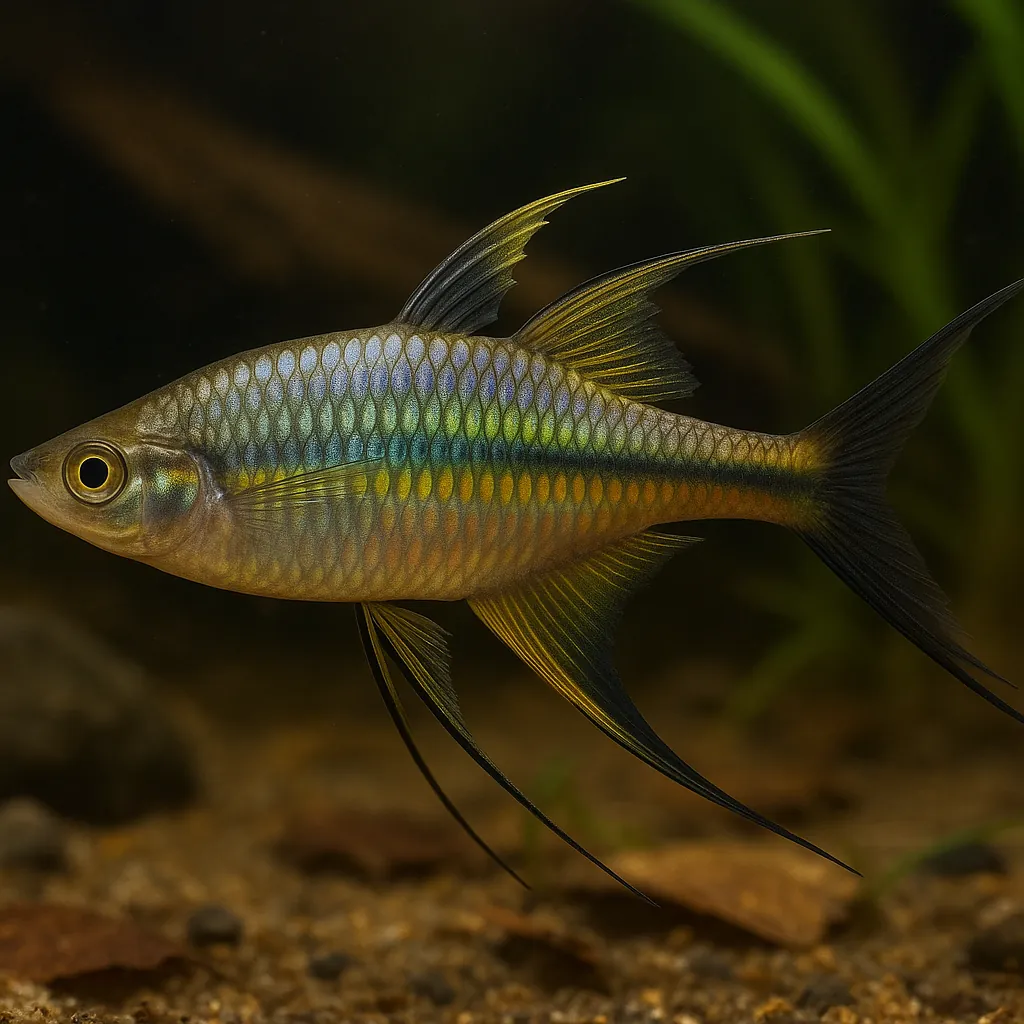
Threadfin rainbowfish
Introduction
The Threadfin Rainbowfish (Iriatherina werneri) is a captivating freshwater species cherished by aquarists for its delicate, elongated fins and vibrant coloration. Native to Australia and Papua New Guinea, these small, peaceful fish are ideal for community tanks, especially those with a focus on planted environments. Their graceful appearance and engaging behavior make them a favorite among hobbyists seeking to add a touch of elegance to their aquariums.
What makes the Threadfin Rainbowfish stand out in a home aquarium?
Their unique fin structure and shimmering colors provide a dynamic visual appeal, enhancing the aesthetic of any tank.
Are Threadfin Rainbowfish suitable for beginners?
Yes, with proper care and attention to their specific needs, they can thrive even in the hands of novice fishkeepers.
Care and Environment
Providing optimal care for Threadfin Rainbowfish involves attention to tank size, water parameters, and environmental enrichment.
What is the minimum tank size for a single Threadfin Rainbowfish?
A minimum of 20 liters is recommended for a single fish, but they thrive best in groups.
What tank size is ideal for a group of Threadfin Rainbowfish?
A 120-liter tank is ideal for a group of six or more, offering ample space for swimming and social interactions.
Maintaining water quality is crucial. Aim for a temperature range of 23–28°C, a pH between 6.0 and 7.0, and water hardness of 5–19 dGH. Regular water changes and efficient filtration are essential to keep the environment clean and stable.
Threadfin Rainbowfish prefer tanks with gentle water flow. Overly strong currents can stress them, so adjust filtration outputs accordingly. They are omnivorous and have small mouths, so provide a varied diet of high-quality flake or pellet food, supplemented with live or frozen options like brine shrimp and daphnia. Feed small amounts multiple times a day to mimic their natural foraging behavior.
In terms of decor, a fine gravel or sand substrate is ideal. Incorporate live plants such as Java Fern, Anubias, and floating species like Water Sprite to offer cover and replicate their natural habitat. Ensure open swimming spaces are available, as they are active swimmers. Be mindful of their sensitivity to water quality; sudden changes can be detrimental, so maintain consistent conditions.
Do Threadfin Rainbowfish require specific lighting conditions?
They prefer dim to moderate lighting, which can be achieved through adjustable LED lights or by incorporating floating plants to diffuse light.
How can I prevent my Threadfin Rainbowfish from jumping out of the tank?
They are known jumpers, so it's important to have a well-secured lid on your aquarium to prevent escapes.
Origin and Habitat
Threadfin Rainbowfish are indigenous to the freshwater swamps and slow-moving rivers of northern Australia and Papua New Guinea. They thrive in environments rich in vegetation, often found among dense aquatic plants and floating vegetation like lily pads. These habitats typically feature soft, slightly acidic water with minimal current, providing the calm conditions they favor.
What type of water bodies do Threadfin Rainbowfish inhabit in the wild?
They are commonly found in freshwater marshes, swamps, and slow-flowing rivers with abundant plant life.
How does their natural habitat influence their care in captivity?
Replicating their natural environment with dense planting and gentle water flow in the aquarium helps them feel secure and display natural behaviors.
Temperament and Compatibility
Threadfin Rainbowfish are peaceful and social, making them excellent candidates for community tanks. They are schooling fish and should be kept in groups of at least six to promote natural behavior and reduce stress. Males may display territorial behavior during breeding, but this is generally mild.
What are suitable tank mates for Threadfin Rainbowfish?
Compatible companions include small, non-aggressive species such as tetras, rasboras, danios, and peaceful bottom dwellers like Corydoras catfish.
Are there any fish species to avoid housing with Threadfin Rainbowfish?
Avoid fin-nipping or aggressive species, as Threadfin Rainbowfish have delicate fins that can be easily damaged.
Creating a harmonious tank community involves selecting species with similar temperaments and environmental needs. Providing ample space and hiding spots can further reduce potential conflicts.
Interesting Facts
Threadfin Rainbowfish exhibit fascinating behaviors and characteristics that endear them to aquarists. Males are known for their elaborate courtship displays, where they raise and lower their dorsal fins to attract females. This display not only showcases their vibrant colors but also their unique fin structures.
How can you distinguish between male and female Threadfin Rainbowfish?
Males have more elongated and colorful fins compared to the shorter, less vibrant fins of females.
What is unique about their breeding behavior?
They are egg scatterers, laying eggs among fine-leaved plants or spawning mops. The eggs hatch in about 7–10 days, and the fry are initially very small, requiring infusoria or similarly sized food.
Another intriguing aspect is their sensitivity to water quality. They thrive in stable conditions, and sudden changes can lead to stress or health issues. This sensitivity underscores the importance of regular maintenance and monitoring in their care.
Sources
All information in this article has been gathered from the following reputable sources:
Overview
Recommended Tank Size 31.7 Gallons (for groups of 6 or more) |
Minimum Group Size 6 |
Minimum Tank Volume 5.3 Gallons |
Maximum Adult Length 2 inches |
Average Adult Length 1.6 inches |
Shoaling (6+ required) Yes |
Preferred Water Type Freshwater, soft to moderately hard, slightly acidic |
Temperature Range (°C) 23–28 |
pH Range 6.0–7.0 |
Water Hardness (dGH) 5–19 |
Typical Lifespan (years) 3 years |